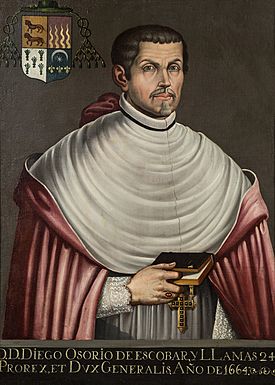Diego Osorio de Escobar y Llamas facts for kids
Quick facts for kids Diego Osorio de Escobar y Llamas |
|
|---|---|
| Bishop of Puebla de los Ángeles | |
 |
|
| Church | Catholic Church |
| Diocese | Puebla |
| In Office | 25 July 1656 – 17 October 1673 |
| Predecessor | Juan de Palafox y Mendoza |
| Successor | Juan de Sancto Mathía Sáenz de Mañozca y Murillo |
| Orders | |
| Consecration | 25 July 1656 by Pope Alexander VII |
| Personal details | |
| Born | c. 1608 A Coruña, Galicia, Spain |
| Died | 17 October 1673 (aged 64–65) Puebla, New Spain |
| Buried | Mexico City Metropolitan Cathedral |
| Coat of arms | |
Diego Osorio de Escobar y Llamas (born around 1608 – died October 17, 1673) was an important leader in New Spain (which is now Mexico). He was a Roman Catholic bishop in a city called Puebla from 1656 to 1673. He also served as the Viceroy of New Spain for a short time in 1664. A viceroy was like a governor who ruled a colony in the name of the king of Spain.
Contents
Becoming a Church Leader
Diego Osorio de Escobar y Llamas started his career in the church in Toledo, Spain. He held several important jobs there, including being a canon (a type of priest) and an inquisitor (someone who investigated religious matters). He was also a vicar-general, which meant he helped manage the diocese (a church district).
In 1655, Pope Alexander VII chose him to become the bishop of Puebla. He officially became a bishop in 1656.
His Time as Bishop of Puebla
Bishop Osorio de Escobar stayed in Puebla until he died in 1673. During his time there, he did many important things for the city and the church:
- He helped build a new convent called La Santísima Trinidad.
- He sped up the building of the city's main cathedral.
- He paid for a special chapel and altar dedicated to Nuestra Señora de Guadalupe.
In 1663, he was asked to become the archbishop of Mexico City, which was an even bigger role. However, he chose to stay in Puebla because he loved his work there. He did manage the Mexico City diocese for a few months until a new archbishop arrived.
While he was bishop, he also helped other bishops start their roles. He was the main person who consecrated (officially made) three other bishops:
- Luís de Cifuentes y Sotomayor, Bishop of Yucatán (in 1660)
- Juan de Sancto Mathía Sáenz de Mañozca y Murillo, Bishop of Santiago de Cuba (in 1662)
- Juan de la Torre y Castro, Bishop of Nicaragua (in 1662)
Serving as Viceroy of New Spain
Diego Osorio de Escobar y Llamas became the Viceroy of New Spain for a short period, from June to October 1664. He took over from the previous viceroy, who was called back to Spain. It seems he didn't really want the job because he preferred his church duties. He resigned as soon as he could to go back to Puebla.
What He Did as Viceroy
Even though his time as viceroy was short, he still made some important decisions:
- He sent money to Cuba to help repair a castle and rebuild the city of Santiago de Cuba, which had been damaged by the English.
- He started a factory to make gunpowder and sent some of it to Cuba.
- He made sure the navy (Armada de Barlovento) was ready to protect the coast of New Spain from attacks.
- He provided money to strengthen the defenses of Campeche. At this time, Spain was still at war with England.
- He improved the postal service, making it much more efficient.
- He also made changes to how mercury was sold and helped settle a disagreement between two groups, the Franciscans and the governor of Yucatán.
Returning to Puebla
After leaving his role as viceroy in 1664, Bishop Osorio de Escobar had some disagreements with the new viceroy. He decided to live quietly in a town called Tlatlauquitepec until 1666. After that, he was able to return to his diocese in Puebla.
He passed away in Puebla in 1673. His body was first buried in the Mexico City Metropolitan Cathedral. Later, it was moved to the convent of La Santísima Trinidad, which he had helped build.
See also
 In Spanish: Diego Osorio de Escobar para niños
In Spanish: Diego Osorio de Escobar para niños

